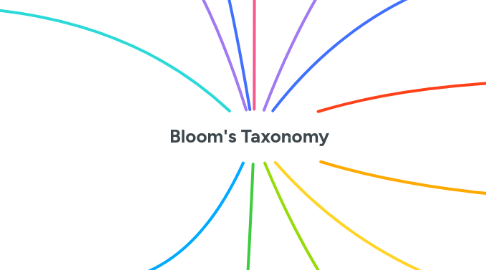Bloom's Taxonomy
von Sebastian Becerra Herrera


1. Learning levels describe the extension from the simple to the complex, the superficial to the deep, the isolated to the integrated.
2. The teacher should guide students from lower to higher levels of learning.
3. Understand
3.1. Clarify, understand and interpret information based on prior knowledge. "interpreting, exemplifying, clssifying, summarizing, inferring, comparing, explaining"
4. Remember
4.1. Remember, recognize information, ideas, and principles in about the same way I learned them. "recognizing, recalling"
5. Why
5.1. learning goals are important to establish in a pedagogical interchange so that teachers and students alike understand the purpose of that interchange.
5.2. Organizing objectives helps to clarify objectives for themselves and for students.
5.3. Having an organized set of objectives helps teachers to: “plan and deliver appropriate instruction”; “design valid assessment tasks and strategies”;and “ensure that instruction and assessment are aligned with the objectives.”
6. Apply
6.1. Select, transfer, and use data and principles to complete a task or find a solution to a problem. "Executing, implementing"
7. Analyze
7.1. Differentiate, classify, and relate conjectures, hypotheses, evidence, or structures to a question or assertion. "Differentiating, Organizing, Attributing"
8. Evaluate
8.1. Assess, evaluate or critique based on specific standards and criteria. "Checking, Critiquing"
9. Create
9.1. Generate, integrate and combine ideas into a product, plan or proposal of new knowledge. "Generating, Planning, producting"
10. Learning Domain
10.1. Cognitive
10.1.1. Intellectual, factual, conceptual, procedural and metacognitive capacities and abilities.
10.2. Psychomotor
10.2.1. Conscious and coordinated movements of the body and its parts.
10.3. Affective
10.3.1. Increase the internalization of positive attitudes towards the object of learning or study.
10.4. Interpersonal
10.4.1. Behavioral skills and attitudinal dispositions "towards and with others".
11. Refletive learning
11.1. Cognitive
11.1.1. Remember, Understand, Apply
11.2. Perceptual
11.2.1. Symbol, figure, sensation
11.3. Psychomotor
11.3.1. Execution, coordination, movement
11.4. Affective
11.4.1. Receive, Reply
11.5. Interpersonal
11.5.1. Search/give, promote, contribute
12. Extensive learning
12.1. Cognitive
12.1.1. Create, Evaluate, Analyze
12.2. Perceptual
12.2.1. Execute, meaning
12.3. Psychomotor
12.3.1. Production, adaptation
12.4. Affective
12.4.1. Propose, characterize
12.5. Interpersonal
12.5.1. Include, summarize, disagree
